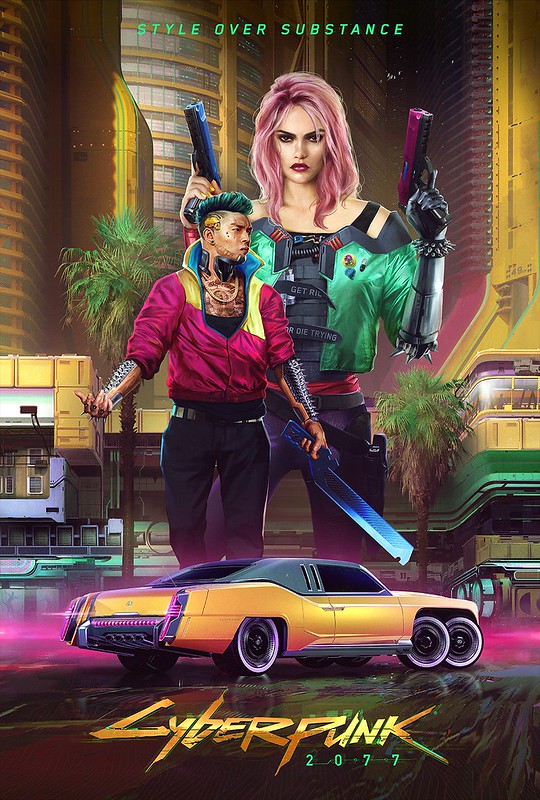“Cyberpunk 2077” contains transgender representation, if only in the barest sense
A role-playing game, as the name suggests, allows the player to assume the role of a fictional character that will interact within the boundaries of the game. Sometimes the role is a pre-constructed character whose looks and lifestyle are already established. Think Geralt of Rivia in “The Witcher” franchise. Sometimes a game allows players to create a custom character through in-game character creation systems. We can often adjust character height and weight, facial features and so on.
We can usually invent characters representing our real likeness or something more imaginative. I created my “Dark Souls 3” character to look as much like my real-life person as I could, while my “Skyrim” character is a lime green lizard. In “World of Warcraft,” I have chosen to be an undead creature with glowing blue eyeballs. These fantastical characters of “Skyrim” and “WoW” allow me to put on a new skin, so to speak. With the character I have created, I am able to imagine what life is like for someone (or something) I am not. Role-playing games, whether of the pencil-and-paper type or the electronic, are by their nature an exploration of empathy.
Gradually, the mainstream market for video games, role-playing and otherwise is opening up to include not just fantasy creatures like lizards and the undead that we can play as, but also representations of people that exist in real life. “WoW” lets me choose a variety of human ethnicities.
Recently attention has been placed on the game character’s gender as well. More than ever before, video games are including LGBTQ+ characters as protagonist options, expanding from the cis-male dominant representation of the video game industry. Last year’s “Tell Me Why,” developed by Dontnod Entertainment, the same studio that created “Life is Strange,” features a transgender man as a lead character. I haven’t played “Tell Me Why” yet, and cannot say that the game blipped on my radar for long before I forgot about it. From what I hear, it employs a nuance to the character that depicts gender as part of, and not the sole focus of, the story.
I did, however, get a chance to play another game that attempts to tackle transgender representation, “Cyberpunk 2077.” Created by the same developer of “The Witcher” games, CD Projeckt Red, “Cyberpunk 2077” had massive—and I mean massive—press attention for the last three years or so. Consumer expectations based on developer-generated hype for “Cyberpunk 2077” were through the roof, and fans were disappointed with the botched December 2020 release (the game does not really work, per se, on the software front).
“Cyberpunk 2077” is a role-playing game that includes a character creation system. At the start of the game I can choose the physical traits for the main character “V,” from hair color to skin tone to eye color to penis size. In a controversial move, “Cyberpunk 2077” allows players to select a visual representation of genitalia, from three different types of penis and one choice titled “vagina,” which depicts a genderless character’s empty private area. I can choose from a selection of breasts I could give V, too, which allows for the representation of the main character with both a penis and breasts if a player so desires.
I commend “Cyberpunk 2077”’s attempt at transgender representation. CD Projekt Red took a chance to give visual representation to a group of us who have been denied it in mainstream art. Maybe if “Cyberpunk 2077” chose to have their transgender representation go beyond the character creation menu—beyond the mere visuals of human sexuality—then I could say the attempt is more than a skin-deep. The game approaches human sexuality in a sensationalist way. “Look at this penis!” and “Look at these boobs!” it says.
The transgender representation as it is depicts trans bodies as sexual without any of that other stuff which makes us human. Who V is does not change much with the inclusion of different genitalia, nor do the other game characters interact with him, or her, differently. Players get to choose from only “he/his” or “she/her” pronouns, a choice which is mapped to V’s vocal tone: select a deep voice if you want to have “he/his,” or a lighter voice if you want “she/hers.”
It seems to me that CD Projekt Red half-baked their attempt at transgender representation. It is unfair to say that “Cyberpunk 2077” does not provide any LGBTQ+ representation at all, given that players can, through V, enjoy romantic relationships with characters of the same gender. Despite its technical flaws, the game is fun to play, and the world is fun to explore. The cyberpunk ideas are interesting, and the characters do have personality to them, even V. I am able to empathize with this fictional character, but the exercise breaks when I remember that my V’s trangender body could just as well be cis-male or cis-female with no differing effect on the game. “Cyberpunk 2077”’s transgender representation is just not as committed to transgender bodies beyond sexual organs, and that’s a major missed opportunity.












V • Mar 19, 2021 at 3:16 pm
Your critique would be enhanced by mentioning Claire, the trans woman character whose heartfelt story serves to juxtopose against the player themselves and the transhumanist culture of Night City. Or mentioning the prevailing Chromanticore advertisements which serve as a meta commentary on trans objectification. Or mention that playing as female V makes Cyberpunk an inherently trans / bigender story as you are sharing your body/soul with Johnny, complete with branching life paths. Or that characters do reference your choices, such as when Kerry, an old friend of Johnny, comments on your female body. There’s also mention of the ecosystem of virtual “brain dance” content where people get to share experiences in a very post-gender way.